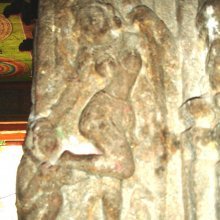Samhata, Saṃhata, Saṃhāta, Saṃhatā: 19 definitions
Introduction:
Samhata means something in Hinduism, Sanskrit, Buddhism, Pali, Marathi, Hindi. If you want to know the exact meaning, history, etymology or English translation of this term then check out the descriptions on this page. Add your comment or reference to a book if you want to contribute to this summary article.
Alternative spellings of this word include Sanhat.
Images (photo gallery)
In Hinduism
Purana and Itihasa (epic history)
Source: archive.org: Puranic EncyclopediaSaṃhatā (संहता).—Second wife of Dhṛtarāṣṭra. She was the niece of Gāndhārī.
Source: Cologne Digital Sanskrit Dictionaries: The Purana IndexSaṃhata (संहत).—A son of Kuntī.*
- * Matsya-purāṇa 43. 9.

The Purana (पुराण, purāṇas) refers to Sanskrit literature preserving ancient India’s vast cultural history, including historical legends, religious ceremonies, various arts and sciences. The eighteen mahapuranas total over 400,000 shlokas (metrical couplets) and date to at least several centuries BCE.
Vyakarana (Sanskrit grammar)
Source: Wikisource: A dictionary of Sanskrit grammarSaṃhata (संहत).—A tone in which two or more accents or tones are mixed up with one another, cf. Bharadvaja Siksa.

Vyakarana (व्याकरण, vyākaraṇa) refers to Sanskrit grammar and represents one of the six additional sciences (vedanga) to be studied along with the Vedas. Vyakarana concerns itself with the rules of Sanskrit grammar and linguistic analysis in order to establish the correct context of words and sentences.
Ayurveda (science of life)
Source: gurumukhi.ru: Ayurveda glossary of termsSaṃhata (संहत):—[saṃhataṃ] Thick

Āyurveda (आयुर्वेद, ayurveda) is a branch of Indian science dealing with medicine, herbalism, taxology, anatomy, surgery, alchemy and related topics. Traditional practice of Āyurveda in ancient India dates back to at least the first millenium BC. Literature is commonly written in Sanskrit using various poetic metres.
Shaktism (Shakta philosophy)
Source: Google Books: ManthanabhairavatantramSaṃhata (संहत) refers to “(being) present (in the house)” [?], according to the Manthānabhairavatantra, a vast sprawling work that belongs to a corpus of Tantric texts concerned with the worship of the goddess Kubjikā.—Accordingly, “The Transmental, which is void, ageless and free of defects is, by it very nature, present in the House of the Full Moon (saṃhata—candrapūrṇasya veśmasya saṃhatā) within the Śāmbhava Kula”.

Shakta (शाक्त, śākta) or Shaktism (śāktism) represents a tradition of Hinduism where the Goddess (Devi) is revered and worshipped. Shakta literature includes a range of scriptures, including various Agamas and Tantras, although its roots may be traced back to the Vedas.
Languages of India and abroad
Pali-English dictionary
Source: BuddhaSasana: Concise Pali-English Dictionarysaṃhata : (adj.) firm; compact. || saṃhaṭa (pp. of saṃharati), collected; drawn together; folded up.

Pali is the language of the Tipiṭaka, which is the sacred canon of Theravāda Buddhism and contains much of the Buddha’s speech. Closeley related to Sanskrit, both languages are used interchangeably between religions.
Marathi-English dictionary
Source: DDSA: The Molesworth Marathi and English Dictionarysaṃhata (संहत).—p S Compact, compressed, close-joined: also close-set, thick-set, strong-knit. 2 Collected together.
Source: DDSA: The Aryabhusan school dictionary, Marathi-Englishsaṃhata (संहत).—p Compact. Collected together. Organised. United.
Marathi is an Indo-European language having over 70 million native speakers people in (predominantly) Maharashtra India. Marathi, like many other Indo-Aryan languages, evolved from early forms of Prakrit, which itself is a subset of Sanskrit, one of the most ancient languages of the world.
Sanskrit dictionary
Source: DDSA: The practical Sanskrit-English dictionarySaṃhata (संहत).—p. p.
1) Struck together, wounded.
2) Closed, shut; मैथिलः श्रुतदेवश्च युगपत् संहताञ्जली (maithilaḥ śrutadevaśca yugapat saṃhatāñjalī) Bhāgavata 1.86.25.
3) Well-knit, firmly united.
4) Closely joined or allied; नसंहतास्तस्य नभिन्नवृत्तयः (nasaṃhatāstasya nabhinnavṛttayaḥ) Kirātārjunīya 1.19.
5) Compact, firm, solid; ततो जज्ञे मांसपेशी लोहाष्ठीलेव संहता (tato jajñe māṃsapeśī lohāṣṭhīleva saṃhatā) Mahābhārata (Bombay) 1.115.12.
6) Combined, joined, keeping together, being in a body, being very close; जालमादाय गच्छन्ति संहताः पक्षिणोऽप्यमी (jālamādāya gacchanti saṃhatāḥ pakṣiṇo'pyamī) Pañcatantra (Bombay) 2.8;5. 11; H.1.34.
7) Of one accord.
8) Assembled, collected.
9) Composite, compound (said of a kind of odour); इष्टश्चानिष्टगन्धश्च (iṣṭaścāniṣṭagandhaśca) ...... संहतः स्निग्धः (saṃhataḥ snigdhaḥ) Mahābhārata (Bombay) 12.184.28 (com. saṃhataścitragandho'nekadravyakalkagataḥ).
1) Strong-limbed, athletic.
11) Killed.
--- OR ---
Saṃhāta (संहात).—One of the 21 hells; Manusmṛti 4.89 (v. l. for saṃghāta).
Derivable forms: saṃhātaḥ (संहातः).
Source: Cologne Digital Sanskrit Dictionaries: Edgerton Buddhist Hybrid Sanskrit DictionarySaṃhāta (संहात).—(m.; = Sanskrit or [Buddhist Hybrid Sanskrit] saṃghāta, as such in Sanskrit but not in meaning 2; § 2.35; not recorded in MIndic), (1) mass, collection: (Jīvakena vaidyarājena…) bhaiṣa- jyataru-saṃhāta-mayaṃ dārikārūpaṃ kṛtaṃ Śikṣāsamuccaya 159.9; sarvaratnayamaka-saṃhāto ([bahuvrīhi] adj., with kūṭāgāro 14) Gaṇḍavyūha 6.17; (2) in acchaṭā-°ta, = acchaṭā-(q.v.)-saṃghāta: ekācchaṭā-°ta-mātram api Śikṣāsamuccaya 214.11, for a single snap of the fingers (jiffy, trice).
Source: Cologne Digital Sanskrit Dictionaries: Shabda-Sagara Sanskrit-English DictionarySaṃhata (संहत).—mfn.
(-taḥ-tā-taṃ) 1. Strong-knit, well-limbed. 2. Compact, close. 3. Joined, attached or approximated to. 4. Closed, shut. 5. Collected, assembled. 6. Struck, hurt, wounded, killed. 7. Acting or making effort together, combining, combined. 8. Closely allied. E. sam with, together with, han to hurt or strike, aff. kta .
--- OR ---
Saṃhāta (संहात).—m.
(-taḥ) One of the twenty-one hells.
Source: Cologne Digital Sanskrit Dictionaries: Benfey Sanskrit-English DictionarySaṃhāta (संहात).— (probably for saṃghāta, q. cf., which is also a v. r.), m. One of the hells, [Mānavadharmaśāstra] 4, 8.
Source: Cologne Digital Sanskrit Dictionaries: Cappeller Sanskrit-English DictionarySaṃhata (संहत).—[adjective] struck together, closely joined, well knit, hard, solid, compact, strong, intense; [abstract] tā [feminine], tva [neuter]
--- OR ---
Saṃhāta (संहात).—[masculine] succinctness, conciseness.
Source: Cologne Digital Sanskrit Dictionaries: Monier-Williams Sanskrit-English Dictionary1) Saṃhata (संहत):—[=saṃ-hata] [from saṃ-han] mfn. struck together, closely joined or united with ([instrumental case]), keeping together, contiguous, coherent, combined, compacted, forming one mass or body, [Āśvalāyana-śrauta-sūtra; Manu-smṛti; Mahābhārata] etc.
2) [v.s. ...] accompanied or attended by ([instrumental case]), [Manu-smṛti vii, 165]
3) [v.s. ...] become solid, compact, firm, hard, [Mahābhārata; Kāvya literature] etc.
4) [v.s. ...] strong-limbed, athletic, [Mahābhārata]
5) [v.s. ...] strong, intensive, [Varāha-mihira’s Bṛhat-saṃhitā]
6) [v.s. ...] ([probably]) complex, composite, compound (said of a [particular] tone and odour), [Mahābhārata]
7) [v.s. ...] struck, hurt, wounded, killed, [Horace H. Wilson]
8) [v.s. ...] n. a [particular] position in dancing, [Saṃgīta-sārasaṃgraha]
9) Saṃhāta (संहात):—[=saṃ-hāta] [from saṃ-han] m. (for saṃ-ghāta, which is often [varia lectio]) conciseness (in, akṣara-s), [Sāhitya-darpaṇa]
10) [v.s. ...] Name of a [particular] hell, [Manu-smṛti iv, 89]
11) [v.s. ...] of one of Śiva’s attendants, [cf. Lexicographers, esp. such as amarasiṃha, halāyudha, hemacandra, etc.]
Source: Cologne Digital Sanskrit Dictionaries: Yates Sanskrit-English Dictionary1) Saṃhata (संहत):—[saṃ-hata] (taḥ-tā-taṃ) a. Strongly knit, compact; joined; collected; shut; struck; killed.
2) Saṃhāta (संहात):—[saṃ-hāta] (taḥ) 1. m. A hell.
Source: DDSA: Paia-sadda-mahannavo; a comprehensive Prakrit Hindi dictionary (S)Saṃhata (संहत) in the Sanskrit language is related to the Prakrit words: Saṃghaa, Saṃhaya.
[Sanskrit to German]
Sanskrit, also spelled संस्कृतम् (saṃskṛtam), is an ancient language of India commonly seen as the grandmother of the Indo-European language family (even English!). Closely allied with Prakrit and Pali, Sanskrit is more exhaustive in both grammar and terms and has the most extensive collection of literature in the world, greatly surpassing its sister-languages Greek and Latin.
Hindi dictionary
Source: DDSA: A practical Hindi-English dictionarySaṃhata (संहत) [Also spelled sanhat]:—(a) compact; assembled, collected, gathered; —[bhāṣā] compact language; —[śailī] compact style.
...
Kannada-English dictionary
Source: Alar: Kannada-English corpusSaṃhata (ಸಂಹತ):—
1) [noun] closely united; fastened firmly together.
2) [noun] become solid; compact.
3) [noun] closely associated or joined with.
4) [noun] thronged; crowded.
5) [noun] physically strong; strong-limbed; athletic.
6) [noun] hurt; injured.
7) [noun] killed.
--- OR ---
Saṃhata (ಸಂಹತ):—
1) [adjective] the condition of being joined, associated, united firmly.
2) [adjective] (dance.) a posture in which one knee is kept on the other.
3) [adjective] (dance.) a joining of both the lips.
4) [adjective] (dance.) a posture of standing in natural position, in which the ankles and the great toes are made to meet each other.
Kannada is a Dravidian language (as opposed to the Indo-European language family) mainly spoken in the southwestern region of India.
See also (Relevant definitions)
Starts with (+5): Samhatabhru, Samhatabhrukutimukha, Samhatahasta, Samhatahastatva, Samhatajanu, Samhatajanuka, Samhatakulina, Samhatala, Samhatam, Samhatamamsa, Samhatamurti, Samhatanga, Samhatangada, Samhatanjali, Samhatapa, Samhatapana, Samhatapucchi, Samhatashva, Samhatastana, Samhatastani.
Ends with: Abhisamhata, Adrisamhata, Aksharasamhata, Asamhata, Kruropasamhata, Patisamhata, Susamhata, Upasamhata, Vajrasamhata, Visamhata.
Full-text (+36): Samhatata, Samhatajanuka, Samhatabhru, Samhatatala, Samhatajanu, Adrisamhata, Abhisamhata, Samhatahastatva, Samhatapucchi, Samhatatva, Samhatahasta, Samhatastani, Samhatya, Samhatashva, Samhatanga, Samhatika, Susamhata, Samhatavrittoru, Samhatabhrukutimukha, Samhatavakkala.
Relevant text
Search found 21 books and stories containing Samhata, Sam-hata, Saṃ-hata, Saṃ-hāta, Saṃhata, Saṃhāta, Saṃhatā; (plurals include: Samhatas, hatas, hātas, Saṃhatas, Saṃhātas, Saṃhatās). You can also click to the full overview containing English textual excerpts. Below are direct links for the most relevant articles:
Manusmriti with the Commentary of Medhatithi (by Ganganatha Jha)
Verse 4.88-90 < [Section X - Gifts not to be Accepted]
Verse 5.114 < [Section XIII - Purification of Substances]
Bhakti-rasamrta-sindhu (by Śrīla Rūpa Gosvāmī)
Verse 2.4.83 < [Part 4 - Transient Ecstatic Disturbances (vyābhicāri-bhāva)]
Rig Veda (translation and commentary) (by H. H. Wilson)
Rig Veda 9.98.6 < [Sukta 98]
The Matsya Purana (critical study) (by Kushal Kalita)
Part 2.1f - The Haihaya Dynasty < [Chapter 3 - Historical aspects in the Matsyapurāṇa]
Prashna Upanishad with Shankara’s Commentary (by S. Sitarama Sastri)
Verse 3.1 < [Prashna III - The origin and nature of Prana]
The Markandeya Purana (by Frederick Eden Pargiter)

